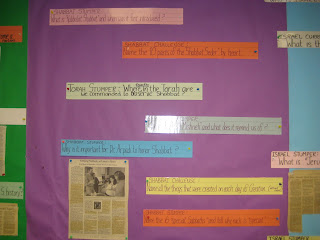I reviewed with the class how the very first Jewish community in what was to become the United States, was established in New Amsterdam (re-named New York when the British conquered it from the Dutch). The year was 1654, and the community consisted of 23 Jews who came originally from Portugal, via Recife, Brazil. They were fleeing the Inquisition. Over the following 140-150 years, most Jews in the United States were of Sephardi (Spanish/Portuguese) origin. They lived in five major commercial cities along the eastern coast - New York, Philadelphia, Newport, Charleston, and Savannah. The second wave of Jewish immigration to the U.S. consisted of approximately 200,000 Jews who came mostly from central Europe - parts of France, Germany, Prussia and a few from Poland. They were escaping religious, economic and social persecution, and consisted largely of young men and women who wanted to start families and "find their fortunes" in a relatively new United States which needed more immigrants to build its economy and secure its territories. And, of course, after 1848, many came after newly discovered gold in California.
Once we had reviewed the above, I shared with the students that for reasons we'll be learning about in our next Edot unit of study, over 2 million Jews entered the U.S.between 1880-1924, and brought with them their Yiddish language and culture. Again, I used the "Heritage: Civilization and the Jews" program to bring the history to life, sharing a video segment and several multimedia presentations relating to the subject of this mass immigration. (minutes 24:54 to 38:05). In this segment, the narrator, Abba Eban, describes the emergence of the American Reform Movement (originally called UAHC - United Association of Hebrew Congregations) among the German Jews, and the emergence of the American Conservative and Modern Orthodox Movements among the mostly eastern European Jews, along with other cultural aspects of this era.
This final lesson about the Jews of the United States (I wish I could continue into the modern era, but unfortunately I don't have the time to do so!), provides me with a perfect segue into our next Edot unit of study - Ashkenazi Jewry, with a focus on the Jews of Poland and Russia. But before we begin this unit, I will be sharing a mini-unit on the holiday of Shabbat, beginning next Sunday (our final class before Thanksgiving break). Eventually, I'll be merging this Shabbat unit of study with that of the Ashkenazi Jews, and our culminating event for what we learn about both will be a family "Shabbat Seder," to be held in our classroom on Sunday, January 29th.
During our past two weekday sessions, we all had a chance to meet our newest music teacher at Isaiah, Eric, during the final 15 minutes of the class. All three 5th and 6th grade tracks met in Shira's classroom, and had a wonderful session, learning two songs - "Betzelem Elohim" and "Ha'Tikva" (not the Israeli national anthem!).
Here he is teaching us the first song:
In preparation for our Shabbat unit of study, I put up new stumpers and challenges on our holiday board:
In case you can't read them in the photo, here they are:
Stumpers: (1 sticker each)
What is "Kabbalat Shabbat" and when was it first introduced?
Where exactly in the Torah are we commanded to observe Shabbat?
What is "Lechem Mishneh" and what does it remind us of?
Why is it important for Dr. Arpadi to honor Shabbat? (newspaper article)
Name the 6 "special Sabbaths" and tell why each is "special."
Challenges: (5 stickers each)
Name the 10 parts of the "Shabbat Seder."
Name all the things that were created on each day of Creation.
A very big thank you goes to Alison for substituting for me this past Sunday while I attended the annual meeting for the Commission for the Preservation of Pioneer Jewish Cemeteries and Landmarks in the West. The students played the Shekel Game, a wonderful way to review what we've learned in class since the start of the school year in our Siddur, Jewish History/Edot and Holiday units of study. They also had another music session with the other two 5th and 6th grade tracks - this time with Revital, our Sunday music teacher.

No comments:
Post a Comment